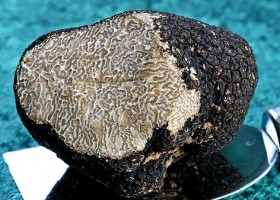Sat 31 Oct 2009
Truffle: The mysterious fungus
Posted by Megan under Alba, Food, Langhe
No Comments
Given the 79th International White Truffle fair in Alba is currently in full swing, I wanted to provide a bit more background on this delicious and mysterious fungus.
Alba is famous for white truffles and although these special fungus grow in various parts of the world (e.g., Albania, Romania, ex-Yugoslavia), it is the Alba white truffle that is considered the ultimate and that attracts hundreds of thousands of visitors a year for the annual truffle fair, that will culminate in the 11th White Truffle World Auction at the Grinzane Cavour Castle on November 8th.
 White truffles (tuber magnatum pico) are a wild fungus and for them to grow, the soil must consist of special properties. Also critical is that this special fungus needs trees because the truffles only grow by absorbing the water, salt minerals and fibers from the soil through the roots of the trees. Even more interesting is that the tree the truffle grows close to influences the flavour of the truffle. For example, if the truffle is growing close to an oak tree, the truffle smell will be more intense than if it grows next to a poplar tree.
White truffles (tuber magnatum pico) are a wild fungus and for them to grow, the soil must consist of special properties. Also critical is that this special fungus needs trees because the truffles only grow by absorbing the water, salt minerals and fibers from the soil through the roots of the trees. Even more interesting is that the tree the truffle grows close to influences the flavour of the truffle. For example, if the truffle is growing close to an oak tree, the truffle smell will be more intense than if it grows next to a poplar tree.
Fresh truffles lose their intensity of scent and flavour quite quickly so they aren’t good for oil to be kept for months. After a few days, fresh truffle oil will loose its flavour, therefore, if you see truffle oil in shops be aware that it likely contains a chemical flavouring.
 Black truffles (see photo to the right) in my opinion lack the intensity of flavour and smell of the white ones. The winter (November to March) ones tend to be the best quality and they are not as highly expensive as the white ones.
Black truffles (see photo to the right) in my opinion lack the intensity of flavour and smell of the white ones. The winter (November to March) ones tend to be the best quality and they are not as highly expensive as the white ones.
Given the going price this year is €250/100 grams, it may be intimidating shopping for a truffle. Be aware that you area allowed to take off a little skin and look at the inside of the truffle. The inside should be light to dark brown. If it is any shade of white, the truffle isn’t mature. If you do buy a truffle and it has not already been cleaned for you, they immerse it in a bowl with equal parts white wine vinegar and water. Very gently brush the outside of the truffle with a brush you might use to clean mushrooms and then pat it dry.
 A truffle hunt is very exciting but can be very depressing too when you spend five hours looking, and you find nothing (personal experience!).
A truffle hunt is very exciting but can be very depressing too when you spend five hours looking, and you find nothing (personal experience!).
Because its flavour is so intense, traditionally truffle is used very simply – shaved over risotto, pasta or often eggs or a carpaccio of veal or beef – so no other flavour can try to compete with it. In the Langhe, expect to pay about €60 for a bowl of the local pasta, tajarin with a generous shaving of white truffles.
Bon Appetite!











